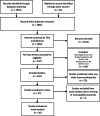Efficacy of Brief Intervention for Unhealthy Drug Use in Outpatient Medical Care: a Systematic Review and Meta-analysis
- PMID: 35419744
- PMCID: PMC9198157
- DOI: 10.1007/s11606-022-07543-z
Efficacy of Brief Intervention for Unhealthy Drug Use in Outpatient Medical Care: a Systematic Review and Meta-analysis
Abstract
Background: The efficacy of brief intervention (BI) for unhealthy drug use in outpatient medical care has not been sufficiently substantiated through meta-analysis despite its ongoing global delivery. This study aims to determine the efficacy of BI for unhealthy drug use and the expected length of effects, and describe subgroup analyses by outpatient setting.
Methods: Trials comparing BI with usual care controls were retrieved through four databases up to January 13, 2021. Two reviewers independently screened, selected, and extracted data. Primary outcomes included drug use frequency (days used) and severity on validated scales at 4-8 months and were analyzed using random-effects model meta-analysis.
Results: In total, 20 studies with 9182 randomized patients were included. There was insufficient evidence to support the efficacy of BI for unhealthy drug use among all outpatient medical care settings for use frequency (SMD = -0.07, 95% CI = -0.17, 0.02, p = 0.12, I2 = 37%, high certainty of evidence) and severity (SMD = -0.27, 95% CI = -0.78, 0.24, p = 0.30, I2 = 98%, low certainty of evidence). However, post hoc subgroup analyses uncovered significant effects for use frequency by setting (interaction p = 0.02), with significant small effects only in emergency departments (SMD = -0.15, 95% CI = -0.25, -0.04, p < 0.01). Primary care, student health, women's health, and HIV primary care subgroups were nonsignificant. Primary care BI revealed nonsignificant greater average use in the treatment group compared to usual care.
Discussion: BI for unhealthy drug use lacks evidence of efficacy among all outpatient medical settings. However, small effects found in emergency departments may indicate incremental benefits for some patients. Clinical decisions for SBI or specialty treatment program referrals should be carefully considered accounting for these small effects in emergency departments.
Registration: PROSPERO (CRD42020157733).
Keywords: emergency department; evidence-based treatment; primary care; screening; student health.
© 2022. The Author(s), under exclusive licence to Society of General Internal Medicine.
Conflict of interest statement
TAF reports personal fees from Mitsubishi-Tanabe, MSD and Shionogi, and a grant from Mitsubishi-Tanabe, outside the submitted work; TAF has a patent 2018-177688 pending. All the other authors report no competing interest.
Figures



References
-
- United Nations Office on Drugs and Crime. World Drug Report 2017: Executive Summary Conclusions and Policy Implications.; 2017. 10.4324/9780429269486-6
-
- WHO. Lexicon of alcohol and drug terms published by the World Health Organization. Terminology and Classification. Published 2019. Accessed November 10, 2019. https://www.who.int/substance_abuse/terminology/who_lexicon/en/
-
- Han B, Hedden SL, Lipari R, Copello EAP, Kroutil LA. Receipt of Services for Behavioral Health Problems: Results from the 2014 National Survey on Drug Use and Health.; 2015. http://www.samhsa.gov/data/sites/default/files/NSDUH-DR-FRR3-2014/NSDUH-...
-
- Substance Abuse and Mental Health Services Administration. Systems-Level Implementation of Screening, Brief Intervention, and Referral to Treatment.; 2013. https://store.samhsa.gov/system/files/sma13-4741.pdf

